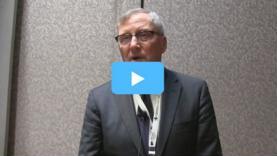Advertisment
ILTS 2016: Professors John Lake (University of Minnesota, MN, USA) and John O’Grady (Kings College Hospital, London) discuss what's novel in immuno-suppression. Also associated article included on Immunosuppression.

Biomarkers emerging as guide on immunosuppression
by Thomas R. Collins
Using the right amount of immunosuppression treatment, but no more than necessary, is a challenge facing clinicians handling transplant patients. Experts here at the 22nd Annual Meeting of the International Liver Transplantation Society discussed emerging strategies for fine-tuning the therapeutic approach.
Josh Levitsky, Associate Professor of Gastroenterology and Hepatology and Surgery-Organ Transplantation at Northwestern University Feinberg School of Medicine, said that a better approach is needed especially because medicine seems to have moved passed a period in which some data had suggested that rejection was not as important to overall outcome as previously thought, leading to the use of less immunosuppression. More recent data have started to reverse that perception.
“Maybe the pendulum has swung back to it being very significant,” Dr. Levitsky said.
He emphasized the need for better markers in immunosuppression either in diagnostic use or in serial use through a treatment course. The idea is to associate biomarker “signatures” with phenotypes, such as rejection, tolerance, Hepatitis C fibrosis, or renal disease.
“That phenotype has to be very well-characterized,” he said.
A recent study gives some indication of what might be possible, Dr. Levitsky said. Researchers found that infection could be lessened or avoided in a certain percentage of patients by reducing immunosuppression when an assay found a suppressed immune response.
“I think this gives us a hint that an immune activation assay, or more specific biomarkers, could potentially guide management and help you modify therapy,” he said.
At his center, researchers analyzed blood samples for mRNA signatures and found that the signatures have the “potential” — a word Dr. Levitsky stressed — to enhance the decision-making in the need to perform a liver biopsy, if associations with phenotypes, including acute rejection and acute dysfunction that is non-viral without rejection.
Jacqueline O’Leary, MD, MPH, Medical Director of the Liver and Transplant Unit at the Baylor Simmons Transplant Institute said the use of biomarkers to guide therapy still needs large, long-term studies that use serial biopsies. But she said a valuable tool could be the acute antibody-mediated rejection (aAMR) score developed by her center in collaboration with others. The score is the sum of portal vein endothelial cell hypertrophy, portal eosinophilia, and eosinophilic venulitis divided by the sum of lymphocytic portal inflammation and lymphocytic venulitis.
The score been found to have a strong correlation with acute antibody-mediated rejection in a training cohort and in a validation cohort.
Dr. O’Leary downplayed the value of donor-specific antibodies as a sign of antibody-mediated rejection, and said that other biomarkers could be far more valuable.
But she added, “Therapy can only happen once we have a defined and agreed upon phenotype.”
References
Ravaioli M, Neri F, Lazzarotto T, et al. Immunosuppression Modifications Based on an Immune Response Assay: Results of a Randomized, Controlled Trial. Transplantation. 2015 Aug;99(8):1625-32.
O’Leary JG, Michelle Shiller S, Bellamy C, et al. Acute liver allograft antibody-mediated rejection: an inter-institutional study of significant histopathological features. Transplantation. 2015 Aug;99(8):1625-32.





